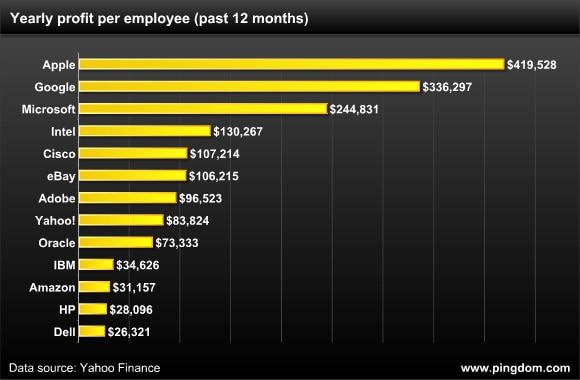
Apple earned a massive profit of $419,528 per employee in the past 12 months. That beats Google, Microsoft, Intel and a bunch of other big tech companies by quite some margin.
One reason (of several) that profit per employee is such an interesting metric is because it gives you a number that doesn’t depend so much on the size of the company. In other words, it becomes easy to compare companies of different sizes.
We have calculated the yearly profit per employee for a selection of big tech companies that are publicly traded on NYSE and NASDAQ: Apple, Google, Microsoft, Intel, Cisco, eBay, Adobe, Yahoo, Oracle, IBM, Amazon, HP, Dell.
In this article we look both at the current situation and compare it with the very different situation back in 2008.
Profit per employee for the past 12 months
We’ve already revealed the number for Apple, but here are the rest:

Apple is not only in the lead, it is in the lead by quite some margin. Its profit per employee is 1.25x that of Google’s and 1.71x that of Microsoft’s.
This is of course a direct result of Apple’s rapidly growing profits. Apple has never been as profitable as it is now, not even close. Just look at Apple’s profit over time.
What a difference a couple of years make
We did a similar survey a couple of years back, so we thought it would be interesting to compare the situation back in 2008 with that of today. Here is the exact same chart as above, but with the numbers for 2008 added for comparison.

The chart is sorted by the current yearly profit per employee.
In 2008, Google was leading this list, but now Apple has surpassed it by quite some margin. This isn’t because it’s not going well for Google, but rather because it’s going spectacularly for Apple.
A few observations on the numbers:
- Apple’s profit per employee has grown 2.8x since 2008.
- Intel’s profit per employee has doubled since 2008.
- Google’s profit per employee has grown 1.8x since 2008.
- Microsoft’s profit per employee has grown 1.3x since 2008.
- Yahoo actually seems to have become more profitable the past couple of years, in spite of all the bad press.
- Some of these companies have lower profits per employee now than in 2008: Cisco, eBay, Adobe, Amazon (barely) and Dell.
Employee growth
Since we are discussing “per employee” numbers in this article, you might be interested in knowing just how many employees these companies have, and how they have changed between 2008 and now.

When you look at these numbers, Apple’s top position in this survey becomes all the more impressive. The company has added more than twice as many new employees as Google in the past couple of years, and passed Google anyway.
A couple of other observations:
- Yahoo has exactly the same number of employees now as in 2008.
- Microsoft has actually shrunk its operation by 2,000 employees.
- It’s not so strange that HP’s and IBM’s profit per employee isn’t that high. There must be significant overhead running such large operations.
Time for a raise?
Many of the companies in this article have managed the impressive feat of both growing in size and increasing the profit per employee, although as you saw, Apple is in a league of its own.
Part of this may be the result of the general financial upswing the world has seen since the recession that affected many countries back in 2008, but if you look at Apple’s profits they never faltered even then.
No wonder why Apple is so popular on the stock market.
We have no idea how much the people at Apple are earning, but we wonder how many of them would be asking for a raise if they saw this article… 😉
Disclaimer: Keep in mind that we here at Pingdom are techies, not financial analysts. If you make investments based on this article and end up losing money, don’t blame us.
Money photo by Tracy Olson.


























